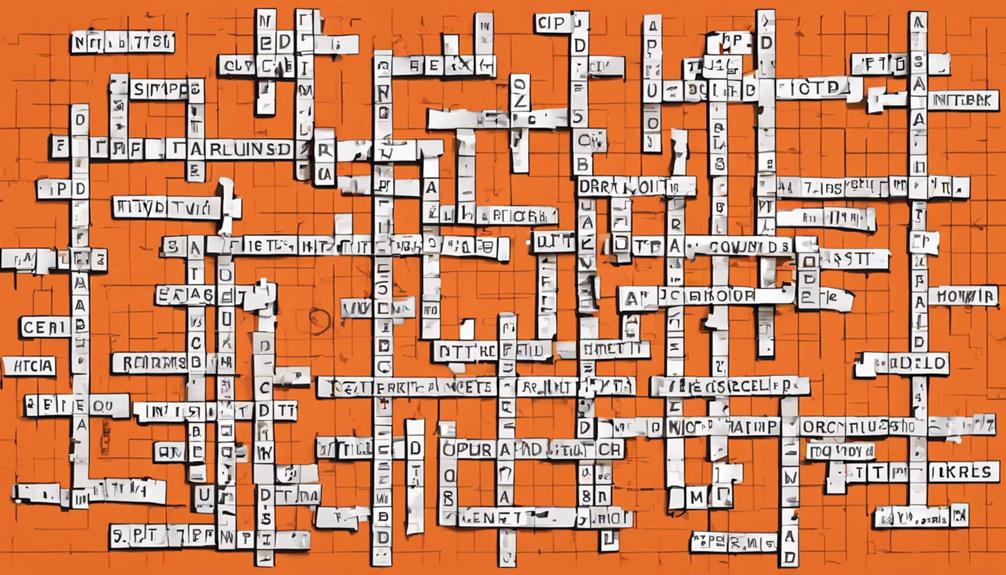Ready to immerse yourself in your computer networking skills to the test? The Computer Network Pro Crossword offers a fun and challenging way to showcase your knowledge. You'll tackle challenges like slow internet speeds and enhancing network security. Explore networking terminology and best practices for routers and switches. Learn about firewalls, security protocols, and essential networking concepts. Get ready to crack the code on OSI models, TCP, UDP, and more. If you're up for the challenge, this crossword is your chance to prove your expertise in computer networks.
Key Takeaways
- Troubleshooting common network issues like slow speeds and connectivity problems.
- Optimize network performance through proper design and segmentation.
- Implement quality of service (QoS) techniques for enhanced efficiency.
- Ensure secure router and switch configurations for network stability.
- Enhance network security with firewalls, encryption, and intrusion detection systems.
Puzzle Overview

Get ready to immerse yourself in the Puzzle Overview of the Computer Network Pro Crossword. This crossword puzzle explores essential aspects of computer networks, including network troubleshooting techniques and the benefits of cloud computing.
When it comes to network troubleshooting techniques, the crossword will challenge you to identify solutions to common network issues such as slow internet speeds, connectivity problems, and security breaches. By solving these clues, you'll enhance your understanding of how to diagnose and resolve network problems efficiently.
Additionally, the puzzle highlights the benefits of cloud computing, where you'll encounter clues related to increased scalability, cost-effectiveness, and improved accessibility of data and applications.
Understanding the advantages of cloud computing is important in today's technology-driven world, and this crossword will test your knowledge on why businesses and individuals are increasingly adopting cloud-based solutions.
Networking Terminology Clues
Prepare to test your knowledge with the Networking Terminology Clues section of the Computer Network Pro Crossword.
When it comes to network troubleshooting tips, it's important to be familiar with common networking issues that can arise. Understanding these common problems, such as connectivity issues, slow network speeds, or configuration errors, will help you navigate and resolve them efficiently.
On the other hand, mastering network design strategies is vital for optimizing your network's performance. Implementing best practices for network optimization, like segmenting your network, using quality of service (QoS) techniques, or ensuring proper security measures, can greatly enhance your network's overall efficiency and reliability.
Whether you're a seasoned network professional or just starting in the field, the Networking Terminology Clues will challenge your understanding of key concepts and terms essential for troubleshooting and designing effective networks.
Router and Switch Questions

Explore essential questions about routers and switches to deepen your understanding of network infrastructure. When it comes to routers and switches, understanding network troubleshooting techniques is vital. What're some common networking mistakes that can impact the performance of your network? Knowing how to identify and rectify these issues is key to maintaining a stable network environment.
Additionally, what're the best practices for router configuration? Proper router configuration can enhance network security and efficiency.
Understanding how to optimize switch performance is also essential. What steps can you take to make sure that your switches are operating at their best capacity?
Firewall and Security Challenges
Understand the importance of firewall technology in defending your network against security threats. Firewalls act as barriers between your network and potential cyber attacks, preventing unauthorized access and malicious activities. To enhance your network security further, consider implementing data encryption techniques to protect sensitive information from being intercepted and misused by cybercriminals.
| Cyber attacks prevention | Data encryption techniques |
|---|---|
| Intrusion detection systems | AES encryption |
| Network segmentation | SSL/TLS protocols |
| Access control lists | Public key infrastructure |
Protocol Puzzles

Explore the world of protocol puzzles to unravel the intricate communication standards used in computer networking.
When delving into the OSI model breakdown, you encounter a structured approach to understanding how data is transmitted across a network. The OSI model consists of seven layers, each serving a specific function in the communication process, from the physical transmission of data to the application layer that interacts with end-user applications.
In the TCP vs. UDP comparison, the choice between Transmission Control Protocol (TCP) and User Datagram Protocol (UDP) depends on the requirements of the communication. TCP provides reliable, ordered, and error-checked delivery of data packets, suitable for applications such as web browsing and email.
On the other hand, UDP offers faster transmission with no guarantee of delivery, making it ideal for real-time applications like voice over IP (VoIP) and online gaming.
LAN Vs. WAN Quizzes
Comparing LANs and WANs through quizzes can provide a hands-on approach to understanding their differences in network scope and functionality. One common aspect to explore in these quizzes is the bandwidth comparison between LANs and WANs. LANs typically offer higher bandwidth compared to WANs due to their localized nature, enabling faster data transfer speeds within a limited area. On the other hand, WANs cover larger geographical areas and may experience slower data transfer rates due to the extended distances data must travel.
Another interesting point for quizzes is the network topologies discussion. LANs commonly use bus, ring, star, or mesh topologies, depending on the specific requirements of the network. In contrast, WANs may implement more complex topologies like hub-and-spoke or partial mesh to optimize connectivity over vast distances. By engaging in quizzes that explore these topics, you can gain a deeper understanding of how LANs and WANs differ in their design and functionality.
| LAN | WAN |
|---|---|
| Higher bandwidth | Slower data transfer |
| Localized network | Extended geographical coverage |
| Various topologies | Complex topologies |
Solutions and Explanations

Delving into the solutions and explanations for LAN and WAN differences can enhance your comprehension of computer networking concepts. When troubleshooting network issues, it's crucial to take into account common problems that may arise in both LANs and WANs.
Network troubleshooting tips can help you address issues efficiently. For LANs, common problems often include network congestion, which can be resolved by optimizing bandwidth usage and identifying devices causing the congestion.
In contrast, WANs may encounter latency due to long-distance data transmission, which can be mitigated through network optimization techniques like using proxy servers or content delivery networks.
Understanding these common network issues explained can empower you to proactively maintain and enhance your network performance. By recognizing the distinctions between LANs and WANs and implementing appropriate solutions, you can guarantee smooth and efficient data communication within your network infrastructure.
Remember to regularly monitor your network, update your hardware and software, and seek professional assistance when needed to keep your networks running smoothly.
Conclusion
Now that you've completed the computer network pro crossword, you should have a better understanding of networking terminology, router and switch functions, firewall and security measures, protocols, and the difference between LAN and WAN.
Keep practicing and challenging yourself with more networking puzzles to continue expanding your knowledge and skills in the field.
Good job on completing the crossword!




